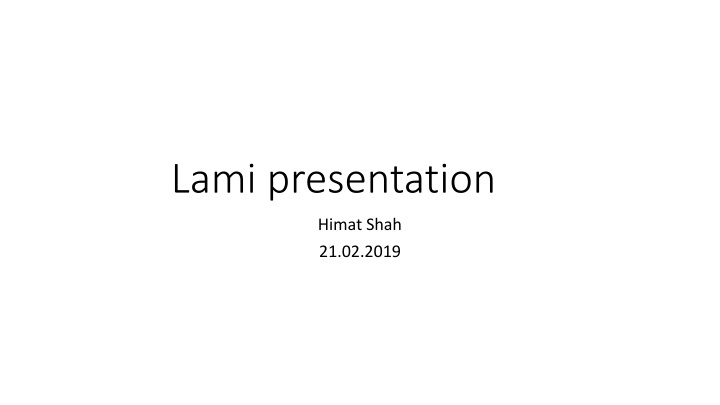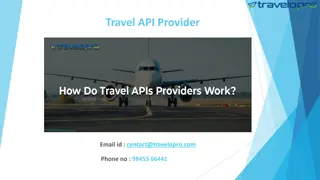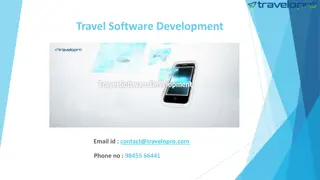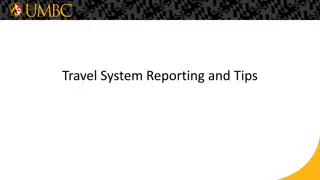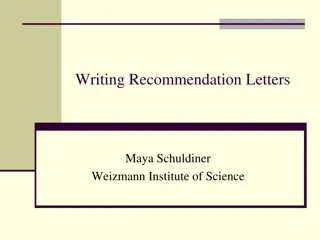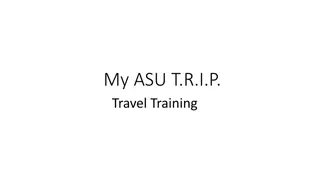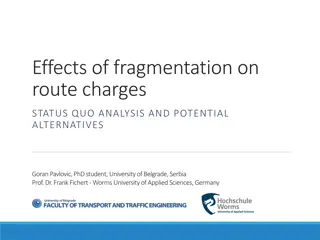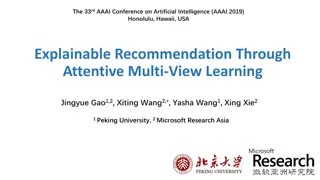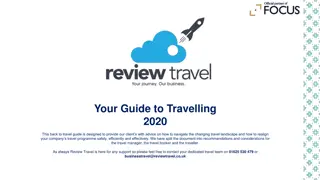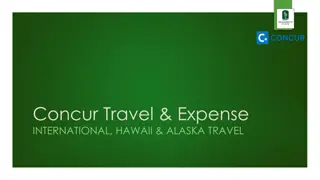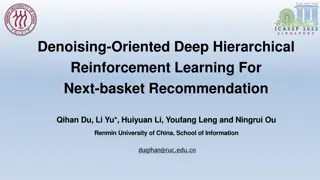Efficient Keyword-Aware Travel Route Recommendation System
This presentation discusses an efficient keyword-aware travel route recommendation system that leverages user-generated content and location-based social networks to provide diversified and representative travel routes. The system aims to address the challenge of restricting users to limited query options while considering factors such as time, route attractiveness, and user preferences. By utilizing keyword-based recommendations and scoring features, the system offers multiple choices tailored to users' interests and preferences.
Download Presentation

Please find below an Image/Link to download the presentation.
The content on the website is provided AS IS for your information and personal use only. It may not be sold, licensed, or shared on other websites without obtaining consent from the author.If you encounter any issues during the download, it is possible that the publisher has removed the file from their server.
You are allowed to download the files provided on this website for personal or commercial use, subject to the condition that they are used lawfully. All files are the property of their respective owners.
The content on the website is provided AS IS for your information and personal use only. It may not be sold, licensed, or shared on other websites without obtaining consent from the author.
E N D
Presentation Transcript
Lami presentation Himat Shah 21.02.2019
A KEYWORD BASED TRIP RECOMMENDER A KEYWORD BASED TRIP RECOMMENDER SYSTEM SYSTEM Yu-Ting Wen, Jinyoung Yeo, Wen-Chih Peng, Member, IEEE, and Seung-Won Hwang Efficient Keyword-Aware Representative Travel Route Recommendation IEEE August 2017
Introduction Introduction Location-Based social network (LSBN) User can share Check-in photos Massive number of routes generated
Traveling Traveling Routes Routes Mobility pridiction Urban planning Traffic management Trip Planning Where ..? When .?? Who .???
Problem ProblemStatment Statment Travel route recommendation problem A deviversed and representative set of recommended travel routes is needed Restricting users to limited query option locations Time Travel routes Attractiveness of POIs Visiting POI Generated by influenced user
Recommender Systems Recommender Systems Query based KRTR Keyword based Possible keywords by user Region London Opera House ,London Bridge Time 10 days
Score Score features features QUERY BASED KRTR KEYWORD BASED Number of places of interest Popularity of place Skyline search Several recommended routes Problems User dependent choices High scoring routes always similar Multichoices keywords Query result similar routes
Recording Routes Check-in points POI Checked in time Group by users and order by time
Example Tourist plan with set of keywords and time [Sunset , SydneyCove, whisky]
Dataset 1. Facebook API 2. Flickr API Users 96 crawled all their friends location records Due to no discription check-in Facebook (API) Checks-in Geo tagged photos Photo id Image Location (lat,lang) User ID Photograph time Textual tag
Challenges Routes missing for matching keywords Similar results and montonous Solution Solution Distance-based Representitive skyline Candidate route generation algorithm
Distance-based Representitive skyline Small no of skyline routes Build on and improves Improves KSTR framework based on scoring features Best descirebed full optimal (skyline) results in terms of features GPS-Tagged photo
Pattern Discovery Scoring mechnism for keywords and POIs Quality of routes ? A review of feature scoring method Candidate route generation algorithms
Keyword Extraction Semantic meaning of keywords 2. Temporal Keywords Specific to time intervals Connection between keywords and trajectories 3. Attribute keywords 1. Geo specific keywords TF and IDF Special for location User frequency Microsoft bing POI frequency Geo code Data Flow (GDA)
Experiments Effectiveness and efficiency Keyword matching accuracy
Conclusion Conclusion Travel route recommendation problem Score the routes on three features Skyline search instead of top-k recommended system KRTR frame work Set of user perferance keywords Outperforms baseline methods in terms of efficiency and effectivenes
Future Work Due to real time online system reduce the computational cost Recording repeated queries and approximate parameters automatically
An An automatic automatic document document classfier on on genetic genetic algorithms classfier system algorithms systembased based Alan Diaz-manriquez , Ana Bertha Rios-alvarado, Jose Hugo Barron- zambrano. 2018
Introduction Text classification is widely used Filter emails Classification problem as the optimization problem Determine how many groups?? Organize results retrieved by Web browsers Classify Web pages
Problem Statement D ={d1,d2 ..dn} C ={c1,c2 cn} Find D in Ck? With maximum similarity as criteria for clustering
Propsed Method Problem of automatic classification of scientific texts as an optimization problem Feature extraction Feature selection Classification Large no of features make classification more expensive Group data from data set Use of evolutionary algorithms
Other Other Techniques Techniques Soft Computing Stochastic optimization techniques Simulated annealing Ant colony optimization Ant colony optimization Particle swarm optimization Tabu search Genetic algorithms Evolutionary algorithms ACM Taxonomy
METHODOLOGY METHODOLOGY Representation of documents Representation of documents Each document presents as a set of keywords ACM Taxonomy Evolutionary algorithm Distance is the averages of distances between couple of keywords Genetic algorithm
Similarity Matrix Distance between keywords Similarity between documents 1 ??????(??,??) ?? ?=1 ?=1 ?? ?? ??,?= ? ?,? = ?(?,?)
ACM Taxonomy Done automaticallyin the form of tree Example Distance between father and son is one brothers is two Floyd-Warshal algorithm was used to find minimum distance in a tree as a graph.
Computer System Organization Applied Computing Hardware Hardware Networks Networks 1 2 Network Type Electronic Commerce Electronic Commerce Hardware Test Hardware Validation Real Time Systems Network Archtecture Architecture ACM TAXANOMY
Genetic Algorithm (GA) Chromosomes Fitness function Crossover and Mutation Parent Selection
GA parameters 1. Chromosomes Representation 2. Fitness Function Davies Bouldin index Assign each word of ACM as whole number index Verify how good grouping is No of groups (k) Grouping function is defined as TC size of the centroid of each group minimization of the DB index K*TC
Davies Davies Bouldin Bouldinindex index A cluster validity index Formula Math function 1/? 1 ?? ????,?= ? ?,?? Evalute the result of clustering in a quantitive way. ? ?i
GA parameters 3. Cross over and mutation One point cross over is used 4. Parent Selection Parent selection is done by the tournament algorithm. Selection is fast and easy to implement
Evalution Test case generator Test case genetor is created for performance evalution
Experimental Design Precision Measure (A) GA-1 GA-2 GA-3 One point cross over Two point cross over Uniform cross over ? ? = ?=1 ?? ? Used for totla amount correctly assinged elements in each clusters Best result achieved by GA with uniform crossover with lower percentages of error rate.
Conclusion Evolutionary algorithm solve classification problem Floyd Warshall algorithm used to obtain minimum distance between two nodes in a graph Find similarity between documetns using (ACM) Three function of crossover implemented Genetic algorithm use to improve index validity
Thank You . Thank You .
